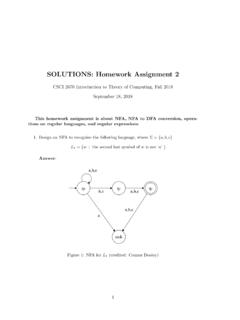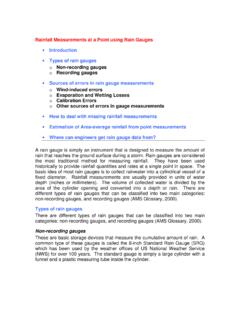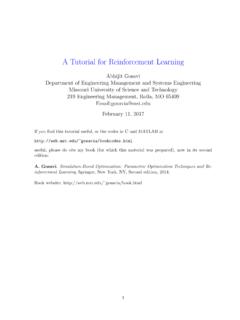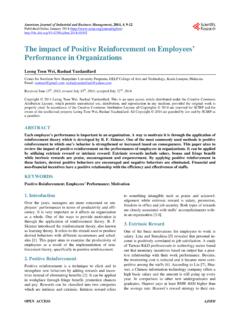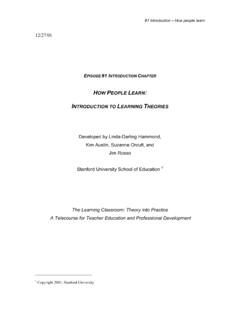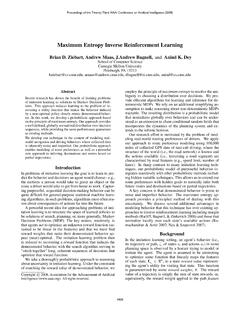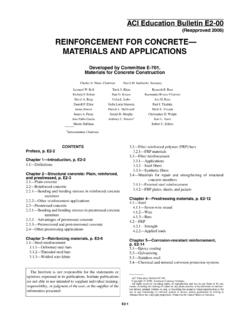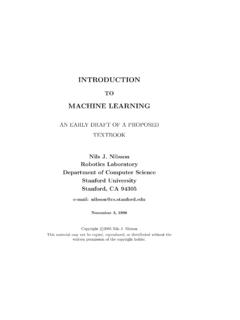Transcription of Introduction to Computational Intelligence
1 Introduction to Computational IntelligenceCSCI/ENGR 8940 Cruise Director: Don Potter(Textbook slides by Eberhartwere edited by Potter for use in CSCI/ENGR-8940)Prof. Walter D. PotterProfessor of Computer ScienceDirector, Institute for Artificial IntelligenceOffice: GSRC-113 Phone: 706-542-0361 Email: Computational Intelligence : Concepts to Implementations by Eberhart and ShiOutline of class session Introduction Discuss handout Review course outline Individual introductions Resources in addition to textbookIntro. to Cl: Course Outline (maybe) Introduction Foundations of CI Evolutionary Computation Neural Networks Fuzzy Logic Computational Intelligence Metrics and Analysis Case StudiesIntroduction Definition of Computational Intelligence Advantages of Cl tools* Can be implemented by domain experts* Relatively short development time This course is applications-oriented* Can solve tough problems Book software assumes students have knowledge of:* C programming Applications selected based on.
2 * Basic concepts,* Experience/practice,* Cool,* Impact factorComputational Intelligence DefinitionComputational Intelligence comprises practical adaptation and self-organizationconcepts, paradigms, algorithms and implementations that enable or facilitate appropriate actions (intelligent behavior) in complex and changing of BookChapter 1 FoundationsChapter 2 Computational IntelligenceChapter 3 Evolutionary ComputationChapter 4 Evolutionary Computation ImplementationsChapter 5 Artificial Neural NetworksChapter 6 Neural Network ImplementationsChapter 7 Fuzzy SystemsChapter 8 Fuzzy System ImplementationsChapter 9 Computational Intelligence ImplementationsChapter 10 Performance MetricsChapter 11 Analysis and ExplanationChapter 12 Case Study SummariesAppendix Computational Intelligence ResourcesGlossaryNote: Chapter 12 and glossary are on book s Chapter Technical and historical discussion of component technologies Foundationsreviews background of component technologies Defines terms; relates to biology and behavioral motivations; discusses myths ; reviews applicationsComputational Intelligence Introduction to Computational Intelligence Adaptation Self-organization Computational Intelligence systems How CI fits into the environment Soft computingEvolutionary Computation History: reviews development history of EC with focus on people Concepts, paradigms and implementations of evolutionary algorithms Evolutionary Computation Theory and Paradigms:reviews genetic algorithms, evolutionary programming, evolution strategies, and genetic programming.
3 Evolutionary Computation Implementations: genetic algorithm and particle swarm Networks Neural network concepts, paradigms, and implementations. Neural Network Theory and Paradigms: terminology, biological bases, survey of architectures and topologies, review of learning paradigms and recall procedures. Neural Network Implementations: back-propagation, self-organizing feature maps, and learning vector Systems Theory, concepts and implementations of fuzzy logic and fuzzy systems. Fuzzy Systems Theory and Paradigms: Fuzzy logic terminology and symbology, fuzzy logic theorems, differences with probability, steps in applying fuzzy logic. Fuzzy Systems Implementation:fuzzy expert Intelligence Implementations Implementation issues including GA and fuzzy adaptation The fuzzy evolutionary fuzzy rule system implementation Packages: EnCog, Neuroph, Neuroshell, Weka, Matlab, Roll-Your-Own, etc. Choosing/using the best methodsMetrics and Analysis Tools needed for CI system development. Performance Metrics:methods for measuring and representing the performance of Computational Intelligence tools.
4 Analysis and Explanation Facilities:graphical representation of neural network weights, development of explanation facilities for CI systems, example of explanation facility for a neural Studies From Book Detection of epileptiform spikes Battery state of charge Schedule optimization Human tremor analysis Control system Neural network approach Fuzzy logic approachOur Case Studies Multiple Fault Diagnosis Network Configuration Harvest Scheduling Multiple Recursive Generators Snake in the Box Solar Radiation Prediction Temperature Prediction OthersThis course is about: Computational tools for uses in practical applications Self-organization Complex adaptive systemsThis course is not about: Everything there is to know about CI and its components Lots of mathematical derivations and proofs Agents Life (whatever that is)Foundations -Outline Introduction Definitions Biological/behavioral bases Myths Application areasIntroduction Focus on practical applications Emphasize the PC platform Implementation is up to youDefinition of IntelligenceWebster s New Collegiate Dictionary defines Intelligence as 1a(1) : The ability to learn or understand or to deal with new or trying situations : REASON; also: the skilled use of reason (2) : the ability to apply knowledge to manipulate one s environment or to think abstractly as measured by objective criteria (as tests).
5 Another Definition of Intelligence The capability of a system to adapt its behavior*to meet its goals in a range of environments. It is a property of all purpose-driven decision Fogel* implement decisions Definition: Evolutionary ComputationMachine learning optimization and classification paradigms roughly based on mechanisms of evolution such as naturalselection and biological genetics. Includesgenetic algorithms, evolutionary programming,evolution strategies and genetic : Artificial Neural Network An analysis paradigm very roughly modeled afterthe massively parallel structure of the brain. Simulates a highly interconnected, parallel Computational structure with numerous relatively simple individual processing : FuzzinessFuzziness: Non-statistical imprecision and vagueness in information and data. Fuzzy Sets model the properties of properties of imprecision, approximation or vagueness. Fuzzy Membership Valuesreflect the membershipgrades in a set. Fuzzy Logicis the logic of approximate reasoning.
6 It is a generalization of conventional DefinitionsParadigm: A particular choice of attributes for a example is the back-propagation paradigmthat is included in the neural network other words, it is a specific example of : A computer program written andcompiled for a specific computer or class of computersthat implements a ComputingSoft computing is not a single methodology. Rather, it is a consortium of computing methodologies which collectively provide a foundation for the conception, design and deployment of intelligent systems. At this juncture, the principal members of soft computing are fuzzy logic, neurocomputing, genetic computing, and probabilistic computing, with the last subsuming evidential reasoning, belief networks, chaotic systems, and parts of machine learning theory. In contrast to traditional hard computing, soft computing is tolerant of imprecision, uncertainty and partial truth. The guiding principle of soft computing is: exploit the tolerance for imprecision, uncertainty and partial truth to achieve tractibility, robustness, low solution cost and better rapport with ZadehDefinition of Computational IntelligenceA methodology involving computing that exhibits an ability to learn and/or to deal with new situations, such that the system is perceived to possess one or more attributes of reason, such as generalization, discovery, association and Computational Intelligence systems usually comprise hybrids of paradigms such as artificial neural networks, fuzzy systems, and evolutionary algorithms, augmented with knowledge elements, and are often designed to mimic one or more aspects of carbon-based biological Intelligence DefinitionComputational Intelligence comprises practical adaptation and self-organization concepts, paradigms, algorithms, and implementations that enable or facilitate appropriate actions (intelligent behavior) in complex and changing Basis: Neural NetworksNeurons: nerve cells.
7 Consist of dendrites, body and an axon; signals flow through differences between biological and artificialneurons (processing elements):* Signs of weights (+ or -)* Signals are AC in neurons, DC in PEs* Many types of neurons in a system; usually onlya few at most in neural networks* Basic cycle time for PC (~100 ns) faster thanbrain (10-100ms) {as far as we know!}Biological NeuronBiological Basis: Evolutionary Computation Ties with genetics, a branch of biology that dealswith the heredity and variation of organisms Chromosomes:structures in cell bodies thattransmit genetic information; humans have 46, in23 pairs Individual patterns in EC correspond tochromosomes in biological systems The genotypecompletely specifies an organism; inEC a structurespecifies a system; in most ECtools, one string specifies a structure, so structureis interchangeable with chromosome. A by Mark EberhartBiological-EC Chromosome Differences Artificial (EC) chromosomes all same length Biological: : bits or real numbers In reproduction, biological cells divide, whileEC cells copy Synthesis of new chromosomes: 50 percentfrom each biological parent, any percentagefrom EC parents.
8 Mutation not intrinsic tobiological system as it is in Logic Behavioral Motivations FL analogous to uncertainty in human experiences( Stop the car prettysoon. ) Fuzziness is associated with nonstatisticaluncertainty FL thus is reflected at the behavioral level of theorganism Fuzziness is not resolved by observation or measurementCI Myths The supercomputer/Nobel laureate myth CI implementations are faster, cheaper andbetter than anything else CI will eliminate need for programming CI is more important than preprocessing Only biology experts can use CI Fuzzy logic is fuzzy Fuzzy logic is a substitute for probability Optimization is possibleApplication Areas: Neural Networks Classification/Prediction Associative memory Clustering or compression Simulation or composition Control systemsApplication Areas: Evolutionary Computation Optimization* Route Finding* Scheduling Classification* Diagnosis (OK, minimal set covering) Configuration (aka, design)Application Areas: Fuzzy Logic Control systems* Vehicles* Home appliances Expert systems* Industrial processes* Diagnostics* Finance* Robotics and manufacturingChapter 1 Final Thoughts Hardware/software distinctions are blurred Emphasis on applicability, not plausibility Not looking for route to intelligent behavior Developer (you) must do active design, develop, test and debug (traditional), plus observation and analytical thinking (not so traditional).
9 Chapter 2: Computational IntelligenceComputational Intelligence : Introduction Adaptation and learning are discussed and compared Self-organization and evolution are discussed Historical views of CI are reviewed Concepts of CI are reviewed, as is how it fits into larger picture Definitions of CI are presented and discussed Work reported here is extension of that done by Marks and BezdekAdaptation versus Learning Adaptation 1:the act or process of adapting : the state of being adapted 2: adjustment to environmental conditions: as a: adjustment of a sense organ to the intensity or quality of stimulation b:modification of an organism or its parts that makes it more fit for existence under the conditions of its environment. Adapt:to make fit (as for a specific or new use or situation) often by modification Fit: suitable, adapted so as to be capable of surviving, acceptable from a particular viewpointAdaptation versus LearningLearning:knowledge or skill acquired by instruction or study syn: knowledgeLearn:to gain knowledge or understanding of or skill in by study, instruction or experience syn:discoverLearning is what an entire intelligent system of AdaptationAdaptation is any process whereby a structure is progressively modified to give better performance in its 1992 Adaptive processes are improvement (amelioration) processes.
10 They are usually not really optimization Adaptation overcomes the barriers of nonlinearity and local optima. It involves a progressive modification of some structure or structures, and uses a set of operators acting on the structure(s) that evolve over time. Adaptation is ..a fundamental process, appearing in a variety of guises but subject to unified study. -J. HollandBarriers to Adaptation Large problem spaces Large numbers of variables Complex and nonlinear fitness functions Fitness functions that change over time and over the problem space Complex and changing environmentsThe Law of SufficiencyIf a solution to a problem is: Good enough (it meets specs) Fast enough Cheap enoughThen it is Adaptation Methodologies Supervised adaptation (training, learning) Unsupervised adaptation (training, learning) reinforcement adaptation (training, learning)Definition ofSupervised Adaptation: "The process of adjusting (adapting) a system so it produces specified outputs in response to specified inputs.

